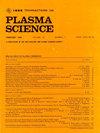Two-Dimensional Particle-in-Cell/Monte Carlo Collisional Simulation of the Post-Arc Breakdown in Vacuum Circuit Breakers
IF 1.3
4区 物理与天体物理
Q3 PHYSICS, FLUIDS & PLASMAS
引用次数: 0
Abstract
Vacuum circuit breakers are widely used in medium-voltage power systems, and the post-arc breakdown is a key factor limiting performance of the vacuum circuit breakers. In this work, a 2-D particle-in-cell/Monte Carlo collisional model is developed to investigate the post-arc breakdown. The residual plasma, metal vapor, inhomogeneous temperature distribution and electron emission on the post-arc cathode surface and various collisions between charged particles, and metal vapor are taken into consideration in the model. Simulation results show that the post-arc breakdown initiates in the vicinity of the post-arc cathode center. At the moment when the post-arc breakdown occurs, a potential hump forms near the post-arc cathode center, and the plasma density increases by two orders, which are consistent with the published result obtained by 1-D hybrid simulation model. Simulation results on the effect of metal vapor density show that the post-arc breakdown occurs earlier with increasing metal vapor density, and the post-arc breakdown cannot occur when the metal vapor density is below 1020 m−3.真空断路器弧后击穿的二维粒子池/蒙特卡洛碰撞模拟
真空断路器广泛应用于中压电力系统,而弧后击穿是限制真空断路器性能的关键因素。本研究建立了一个二维粒子-电池/蒙特卡洛碰撞模型来研究弧后击穿。模型考虑了残余等离子体、金属蒸气、不均匀温度分布、弧后阴极表面的电子发射以及带电粒子和金属蒸气之间的各种碰撞。模拟结果表明,弧后击穿开始于弧后阴极中心附近。在弧后击穿发生的瞬间,弧后阴极中心附近形成电位驼峰,等离子体密度增加了两个数量级,这与已发表的一维混合模拟模型的结果一致。关于金属蒸汽密度影响的模拟结果表明,弧后击穿随着金属蒸汽密度的增加而提前发生,当金属蒸汽密度低于 1020 m-3 时,弧后击穿不会发生。
本文章由计算机程序翻译,如有差异,请以英文原文为准。
求助全文
约1分钟内获得全文
求助全文
来源期刊

IEEE Transactions on Plasma Science
物理-物理:流体与等离子体
CiteScore
3.00
自引率
20.00%
发文量
538
审稿时长
3.8 months
期刊介绍:
The scope covers all aspects of the theory and application of plasma science. It includes the following areas: magnetohydrodynamics; thermionics and plasma diodes; basic plasma phenomena; gaseous electronics; microwave/plasma interaction; electron, ion, and plasma sources; space plasmas; intense electron and ion beams; laser-plasma interactions; plasma diagnostics; plasma chemistry and processing; solid-state plasmas; plasma heating; plasma for controlled fusion research; high energy density plasmas; industrial/commercial applications of plasma physics; plasma waves and instabilities; and high power microwave and submillimeter wave generation.
 求助内容:
求助内容: 应助结果提醒方式:
应助结果提醒方式:


